The Kenruok-en Garndes (Garden of Six Attributes), is Kanazawa – we have been here before and all I can remember is it was 1) beautiful, 2) stinking hot and humid and 3) there were more tourists here than I would prefer (given I was one of them, I am acutely aware of the irony here). Kenrrok-ej was a strolling garden designed and constructed during the Edo period by teh Manda Clain. It was conceived in the 1620 and continuously mainted since then. 

 Kenroku-en is considered one of the Three Great Gardesn of Japan, noted for its beauty across all seasons.
Kenroku-en is considered one of the Three Great Gardesn of Japan, noted for its beauty across all seasons. 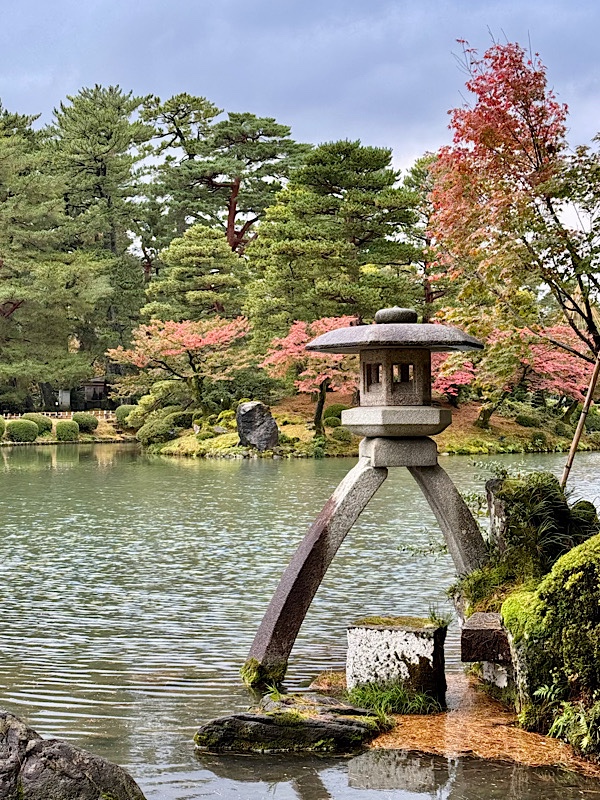
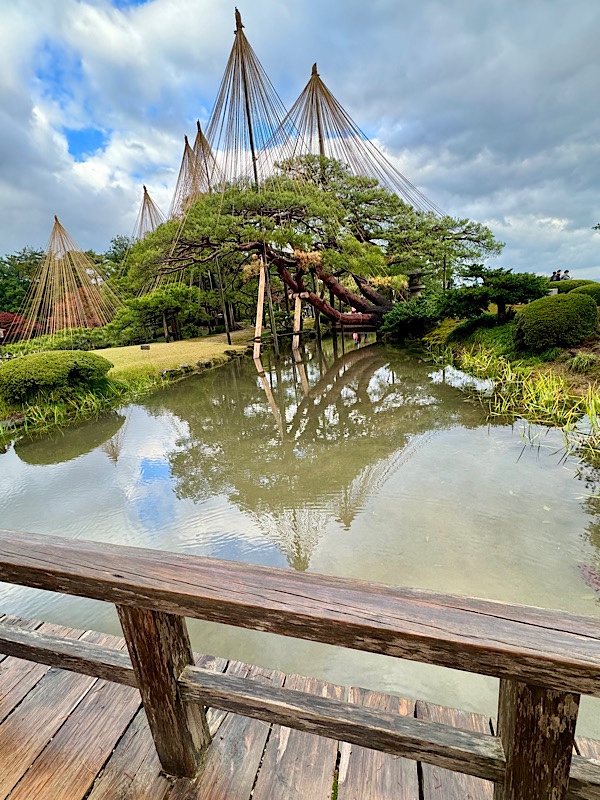
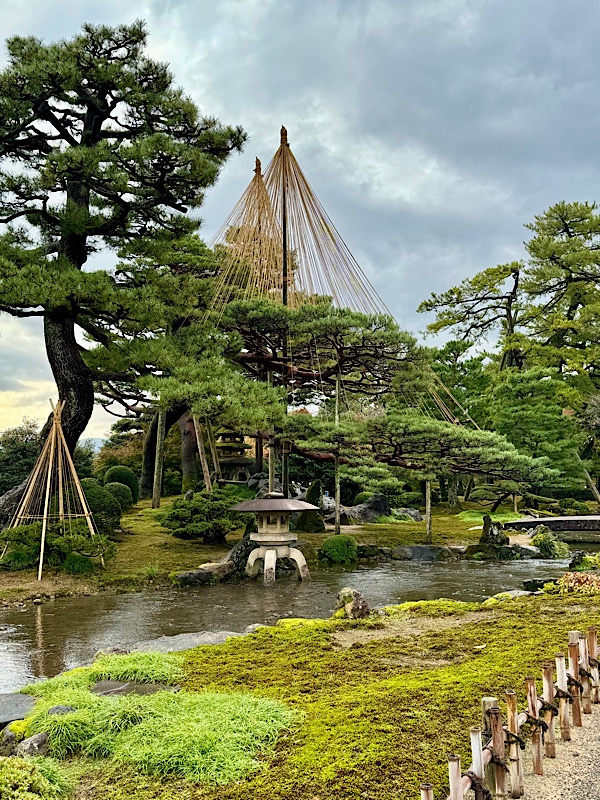

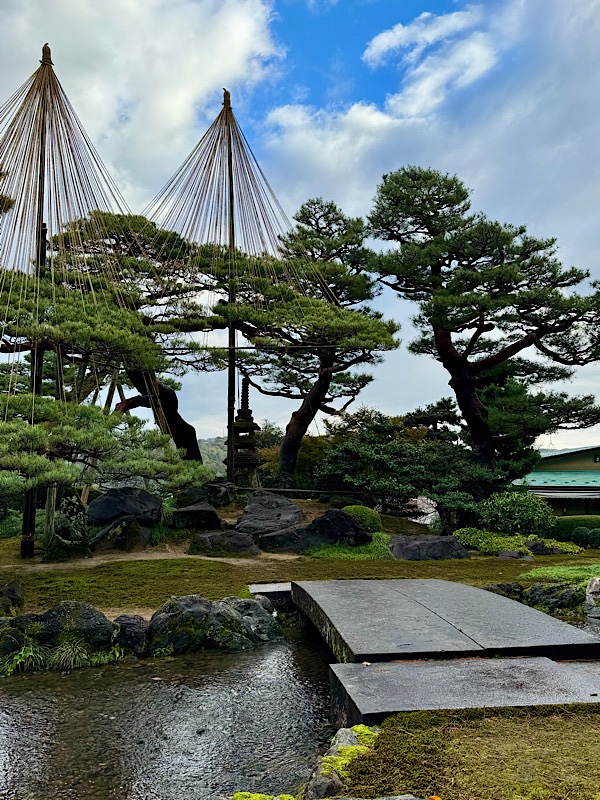
 The gardens are pread over nearly 25 acres, and feature a landscape of meandering paths, two large ponds, several tea houses, and one of Japan’s oldest fountains.
The gardens are pread over nearly 25 acres, and feature a landscape of meandering paths, two large ponds, several tea houses, and one of Japan’s oldest fountains.
It is a site of uncommon beauty and tranquility. It has been open to the public since 1871. 


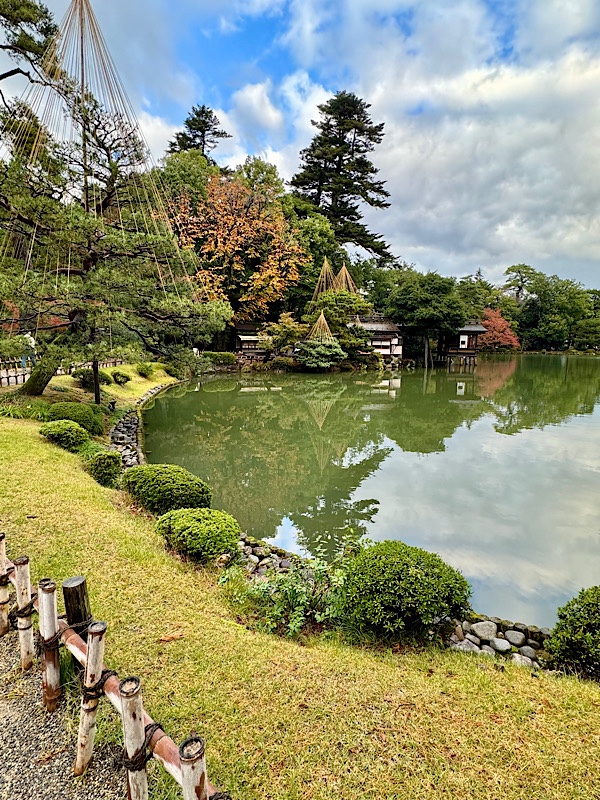









 I just love this place – I’ve been here in summer, but I think I may have to come back in winter to see it in yet another season. Their cherry blossom area is quite small – so there are many more impressive places to go for cherry blossoms.
I just love this place – I’ve been here in summer, but I think I may have to come back in winter to see it in yet another season. Their cherry blossom area is quite small – so there are many more impressive places to go for cherry blossoms.



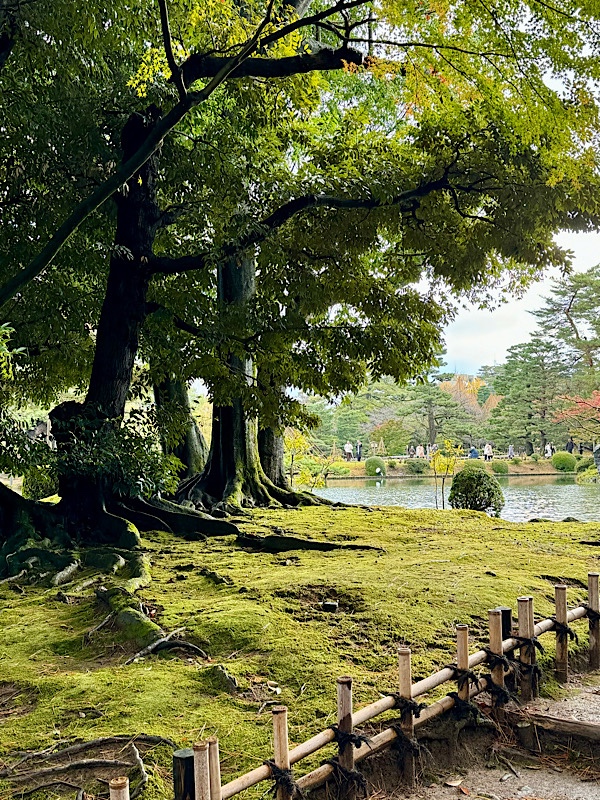
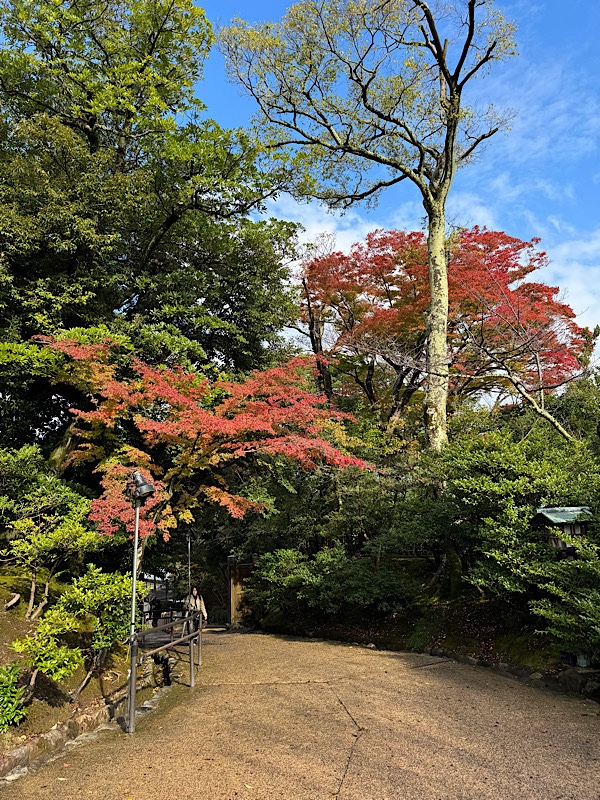
This is just some leaves on the pavement that I thought were pretty.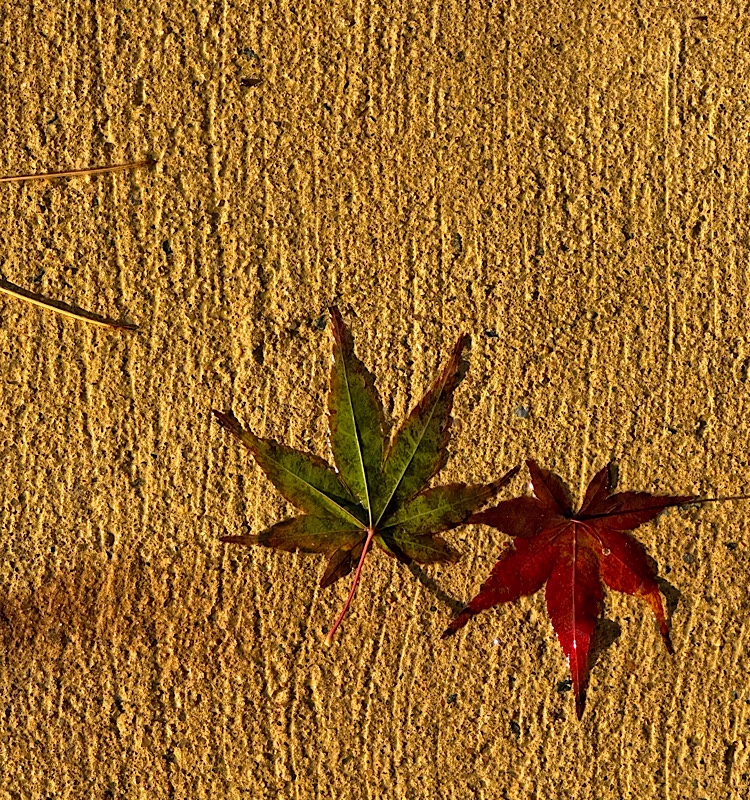
Toyama castle. We went through here last visit, so didn’t go through for a second time. = it’s one of those things you do when you are travelling… decide to visit a place more than once or try to press on and see something new.  After leaving Tokoyama we head towards Gifu Prefecture – the views were gorgeous around every turn. High speed photography isn’t my favourite but I did manage to grab some half decent shots of the landscape.
After leaving Tokoyama we head towards Gifu Prefecture – the views were gorgeous around every turn. High speed photography isn’t my favourite but I did manage to grab some half decent shots of the landscape.  And then we came out of an 11km tunnel* and it was snowing again! 😮
And then we came out of an 11km tunnel* and it was snowing again! 😮
*an 11km tunnel whereupon a cheerful conversation ensued as to what we would do if we were forced to evacuate the tunnel due to an accident or disaster… 😐 
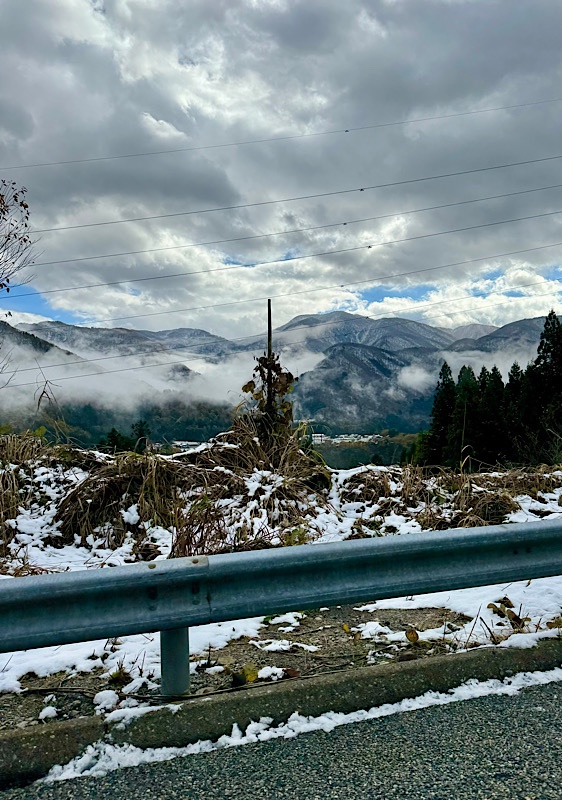 I haven’t packed for full on snow… but glad I bought my Merrell, gortex hiking boots with me!
I haven’t packed for full on snow… but glad I bought my Merrell, gortex hiking boots with me!
 Oh so cold, but so beautiful.
Oh so cold, but so beautiful. As we left Toyama and head towards Gifu Prefecture, we decided to stop at Shirakawa-go.
As we left Toyama and head towards Gifu Prefecture, we decided to stop at Shirakawa-go.
Shirakawa-go is one of Japan’s UNESCO World Heritage Sites (Hmmmm… wonder if there is a Bingo Card for collecting UNESCO sites?!). The cultural area consists of three historic mountain villages over an area of 68 hectares in the remote Shogawa river valley, stretching over the borders of Gifu and Toyama Prefectures.
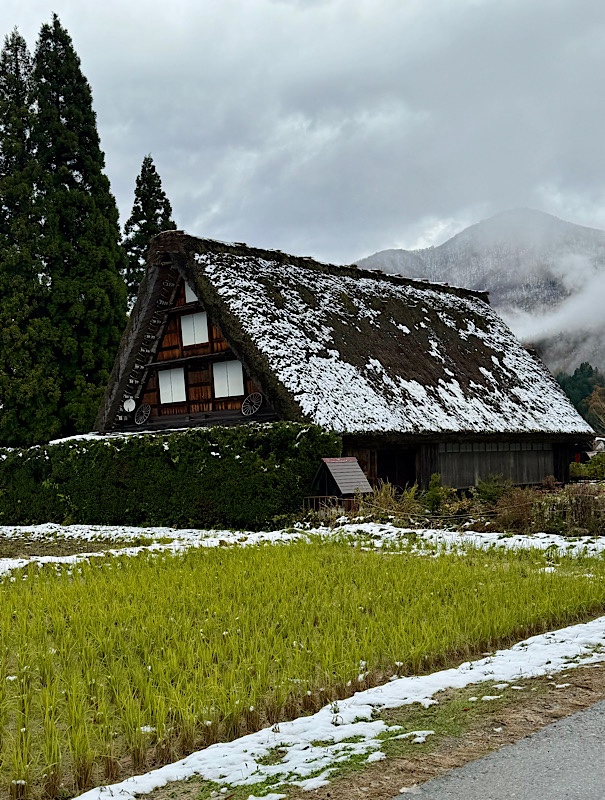

 Shirakawa-gō (白川郷, “White River Old-District”) is located in the village of Shirakawa in Gifu… the village is like an open air museum, but people still live and work here, so there are many private homes interspersed amongst the public museum buildings that tourists might come to visit.
Shirakawa-gō (白川郷, “White River Old-District”) is located in the village of Shirakawa in Gifu… the village is like an open air museum, but people still live and work here, so there are many private homes interspersed amongst the public museum buildings that tourists might come to visit. The thatched roofs are really impressive:
The thatched roofs are really impressive:

The valley where Shirakawa-go is located is in a mountain region that experiences considerable snowfall every winter. This village is well known for it’s clusters of farmhouses that are all constructed in the traditionally architectural style known as gasshō-zukuri. These buildings are designed to easily shed snow from their steep thatched roofs.


 Ω
Ω

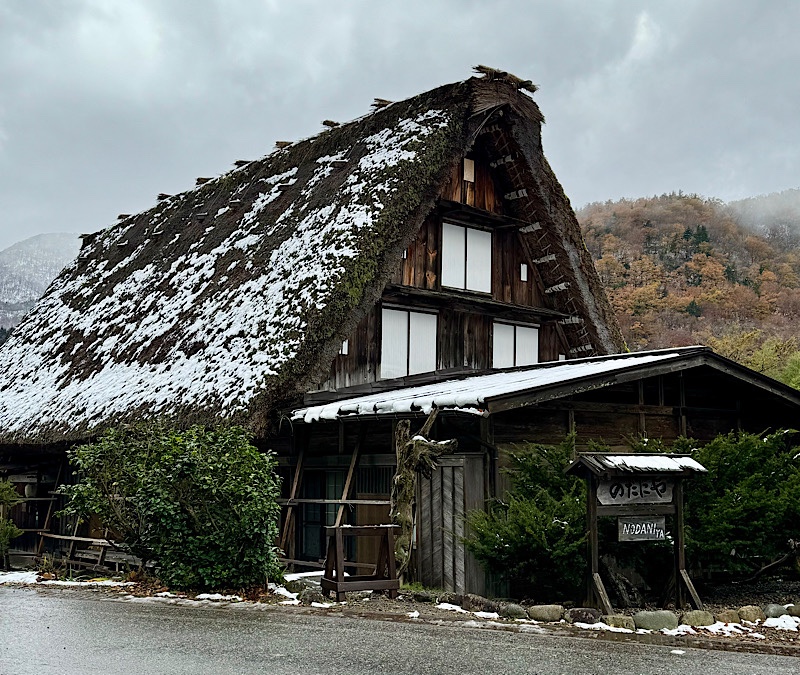
 Interesting info from Wikipedia:
Interesting info from Wikipedia:
“Even today, there is still a system of joint work called “yui” for re-thatching thatched roofs of gassho-zukuri. The thatch replacement was done every 30 to 40 years, and the labor and expense involved was enormous (simply converting the labor cost to today’s value, it is said that the cost to replace one side of the roof alone would be more than 10 million yen), but it was done without compensation.
The procedure for re-thatching was rough as follows.
・Preparation begins at least three years prior to the work.
・The amount of thatch needed and the number of workers are estimated based on the area of the roof.
・Set a date for the work and go around the village to ask for help with the thatching and when it will be done.
・Cut and store enough thatch for the work in advance (a common “thatch field” is reserved for this purpose).
・Determine the division of roles (i.e., those who collect thatch, those who carry it, those who sort thatch, those who prepare ropes and other tools, etc.).
・The above is exclusively the work of men. The women prepare meals for the workers, snacks for the rest, and gifts to celebrate the completion of the work.
・Rarely are both sides of the roof sprayed at the same time, but only one side is completed in two days.
・It takes 200 to 300 workers daily, and it is spectacular to see more than 100 people climbing on the roof.
In recent years, depopulation, the decline of primary industries, and the aging of the population have made it difficult to maintain ties. On the other hand, the National Trust and volunteers from the general public have begun to gather from various parts of the country and work together to re-thatch the roofs. In Shirakawa-go, the organization that performs the tethering is called “koryaku,” and the scope of the tethering is not limited to re-thatching roofs, but extends to all aspects of daily life, including thatching, rice planting, rice harvesting, weeding, chopping firewood, weddings, funerals, and ceremonial occasions.“
That’s nuts!!!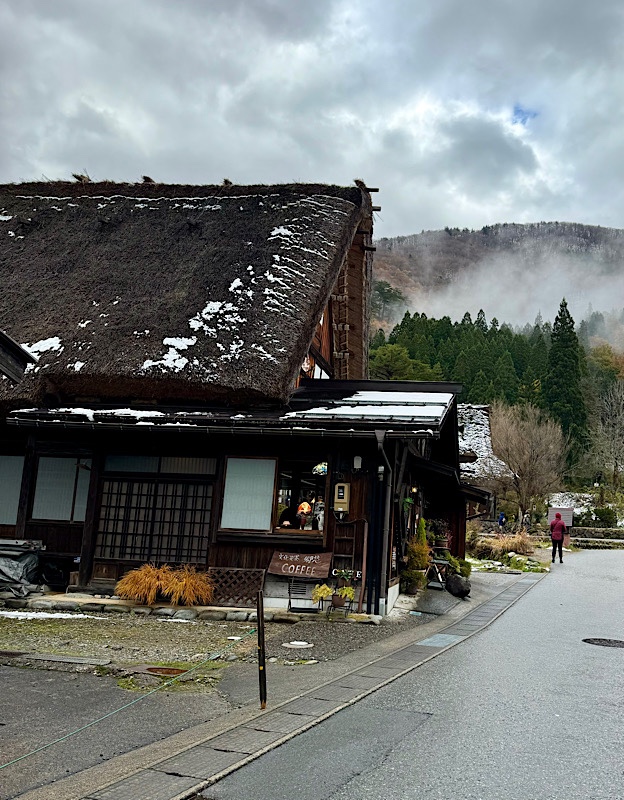



 This statue depicts a person in a ‘Japanese raincoat’ made out of straws. They were particularly common due to availability of materials, well up until the early 1900s…
This statue depicts a person in a ‘Japanese raincoat’ made out of straws. They were particularly common due to availability of materials, well up until the early 1900s…
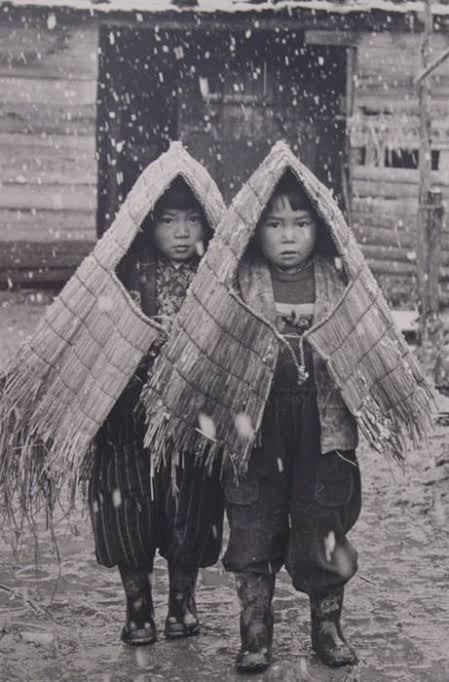
There is even a Pokemon based on people wearing these pointed thatched raincoats…



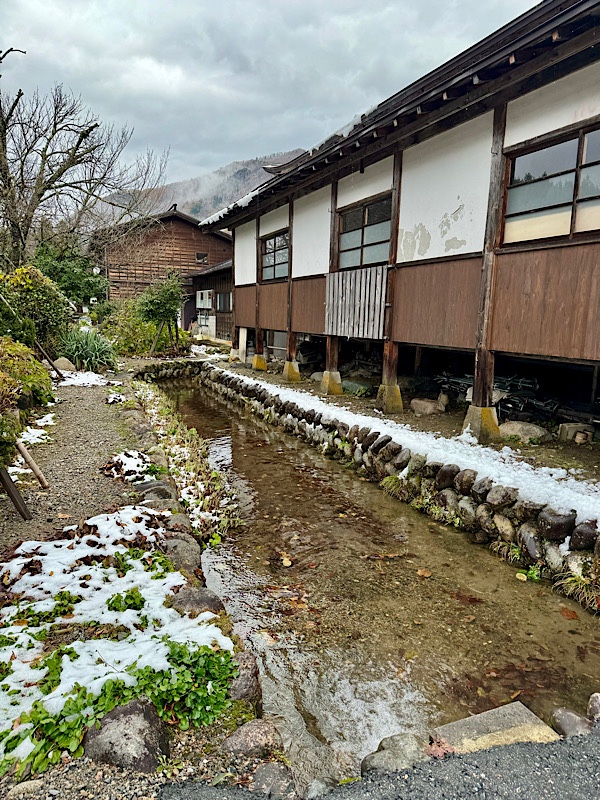



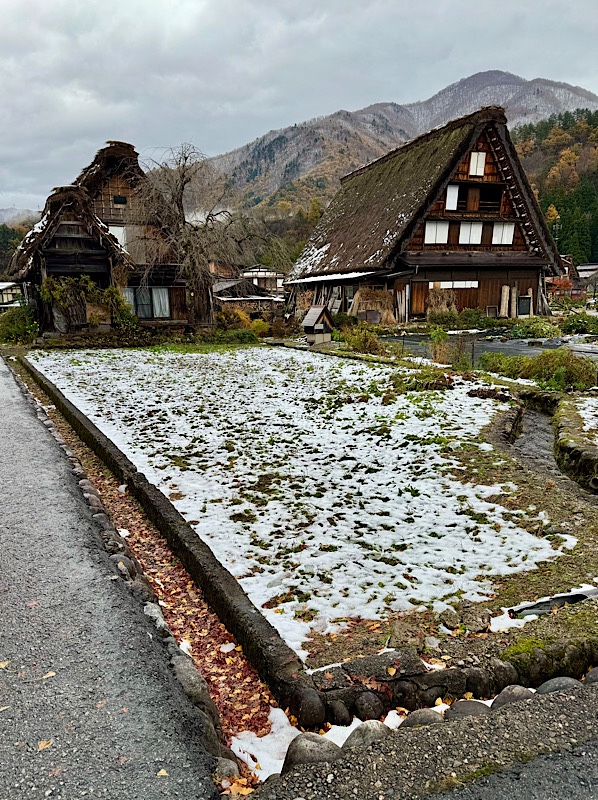 Shirakawa-go is pretty cool – there are still people living and working here, unlike some of the open air museums that are set up with some of these types of buildings just for tourists to visit. The village caters pretty well to visits, though it seems less so at this time of year – less cafes etc open.
Shirakawa-go is pretty cool – there are still people living and working here, unlike some of the open air museums that are set up with some of these types of buildings just for tourists to visit. The village caters pretty well to visits, though it seems less so at this time of year – less cafes etc open.



Gorgeous area, well worth visiting, even if it wasn’t’ for the historical village.






 More snow and more tunnels on the way to Takayama.
More snow and more tunnels on the way to Takayama.
 I’m assumed this said: “Do you need snow chains, stupid?!” But it actually use makes mention of the tunnels ahead. Boring.
I’m assumed this said: “Do you need snow chains, stupid?!” But it actually use makes mention of the tunnels ahead. Boring. 
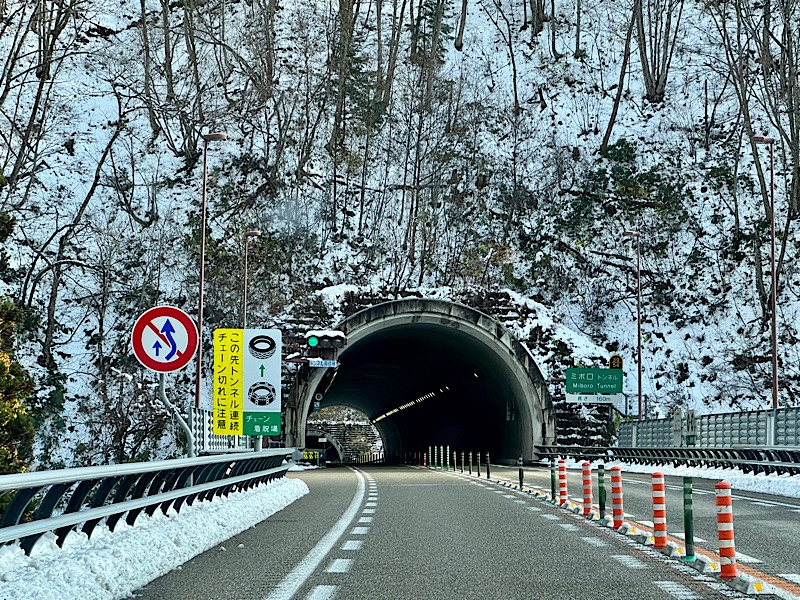

 And some lovely coloured leaves I found on the ground near our ryokan…
And some lovely coloured leaves I found on the ground near our ryokan… 



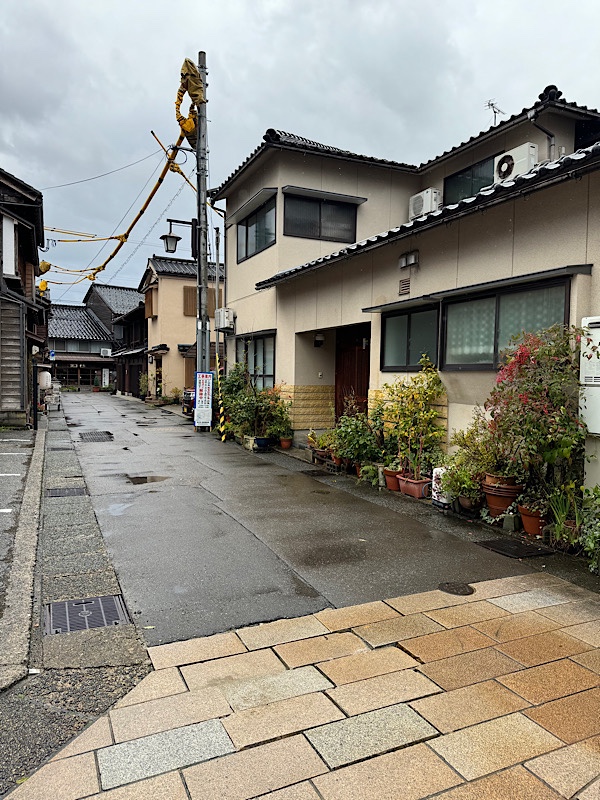
 No, not shops that sell actual gold like the Ponte Vecchio or something, but things covered in ‘gold’… mostly craft items and beauty products either that are either guided in, or contain gold leaf. And, somewhat weirdly loads of food products with edible gold leaf on them – though it’s anybody’s guess why as gold leaf doesn’t seem to have a great deal of taste about it. **shrug**
No, not shops that sell actual gold like the Ponte Vecchio or something, but things covered in ‘gold’… mostly craft items and beauty products either that are either guided in, or contain gold leaf. And, somewhat weirdly loads of food products with edible gold leaf on them – though it’s anybody’s guess why as gold leaf doesn’t seem to have a great deal of taste about it. **shrug**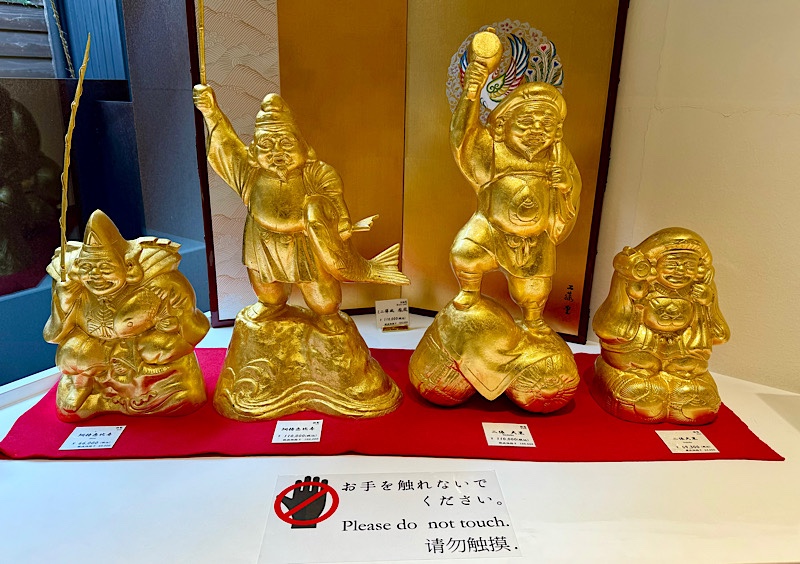 And less of the traditional Japanese lacquerware etc…
And less of the traditional Japanese lacquerware etc… There is quite on lot of hand blown glass products with gold accents of course that seem really popular and always with the saké sets – we’ve noticed that since our last visit to Japan in 2019, there seems to be a trend towards saké jugs shaped like this one, rather than the traditional little carafes that you see used in restaurants a lot. They seem quite neat and I dare say have a much higher capacity than the small carafes, which I imagine is what is putting the restaurant industry off adopting them. 🙂
There is quite on lot of hand blown glass products with gold accents of course that seem really popular and always with the saké sets – we’ve noticed that since our last visit to Japan in 2019, there seems to be a trend towards saké jugs shaped like this one, rather than the traditional little carafes that you see used in restaurants a lot. They seem quite neat and I dare say have a much higher capacity than the small carafes, which I imagine is what is putting the restaurant industry off adopting them. 🙂  I mostly came here to hunt for some new chopsticks. I bought four sets of lovely ebony chopsticks last time we were in Kanazawa and they are the singly most useful and used souvenir object I think I have bought back with me from any trip ever… but so far I haven’t seen any designs that took my eye for every day use at home.
I mostly came here to hunt for some new chopsticks. I bought four sets of lovely ebony chopsticks last time we were in Kanazawa and they are the singly most useful and used souvenir object I think I have bought back with me from any trip ever… but so far I haven’t seen any designs that took my eye for every day use at home. The gold leaf, gold powder body products are destined to remain a mystery to me, though. I was Google Translating posters and signage like a mo-fo today, and do you think I could find anything that was able to explain ‘why’ having gold in your face creams, lotions, potions and actual face masks was supposed to be good for your skin? Nope. Not so much. The one store person I asked what the gold is good for, responded by telling me it is ‘very skin luxuriating for your complexion’. So… yeah. I guess it looks pretty and seems super fancy is the reason for it?
The gold leaf, gold powder body products are destined to remain a mystery to me, though. I was Google Translating posters and signage like a mo-fo today, and do you think I could find anything that was able to explain ‘why’ having gold in your face creams, lotions, potions and actual face masks was supposed to be good for your skin? Nope. Not so much. The one store person I asked what the gold is good for, responded by telling me it is ‘very skin luxuriating for your complexion’. So… yeah. I guess it looks pretty and seems super fancy is the reason for it?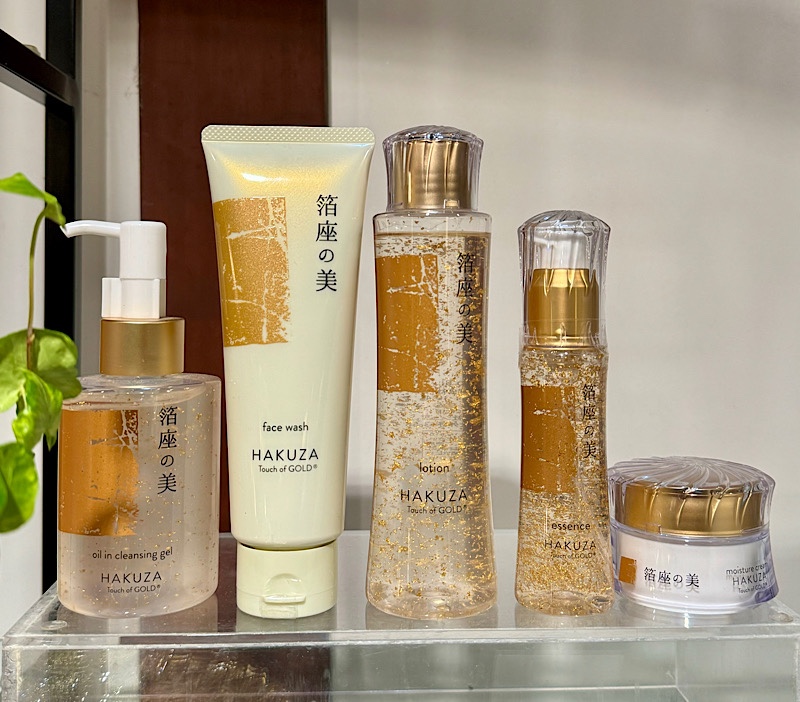

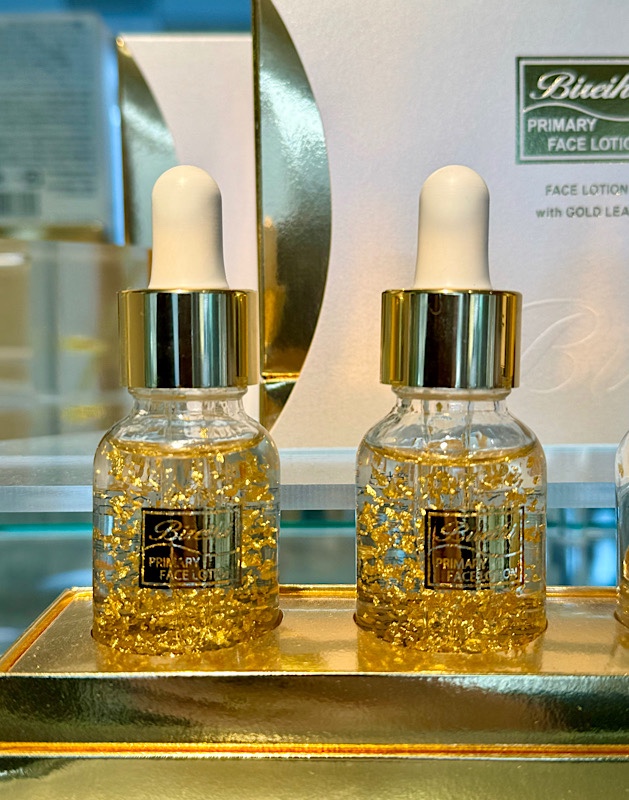






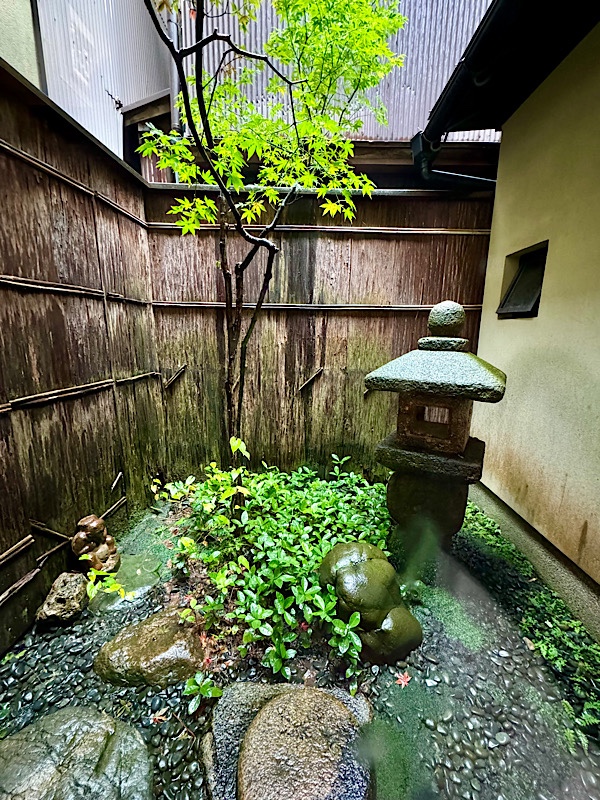
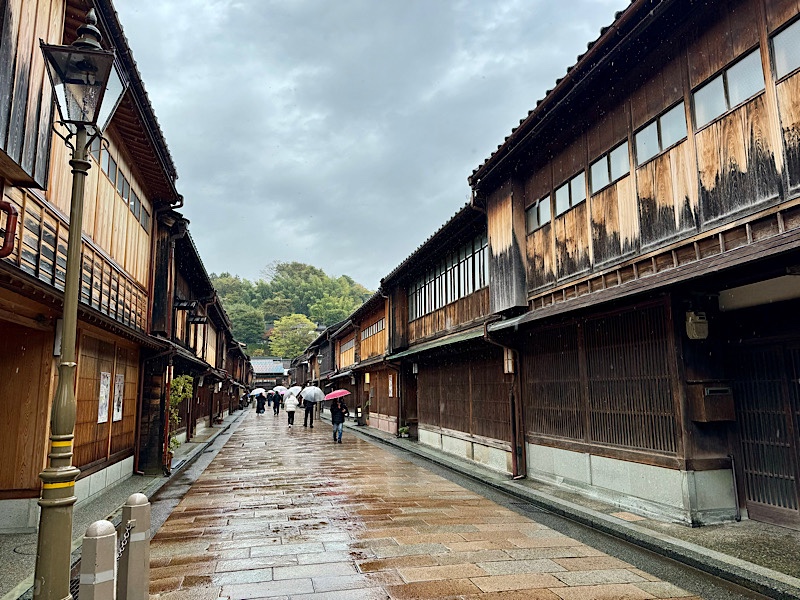
 I promise there were actually quite a few people wandering around here today – I just seem to have taken most of my pictures of these old buildings and winding little streets with hardly any people in them.
I promise there were actually quite a few people wandering around here today – I just seem to have taken most of my pictures of these old buildings and winding little streets with hardly any people in them. 
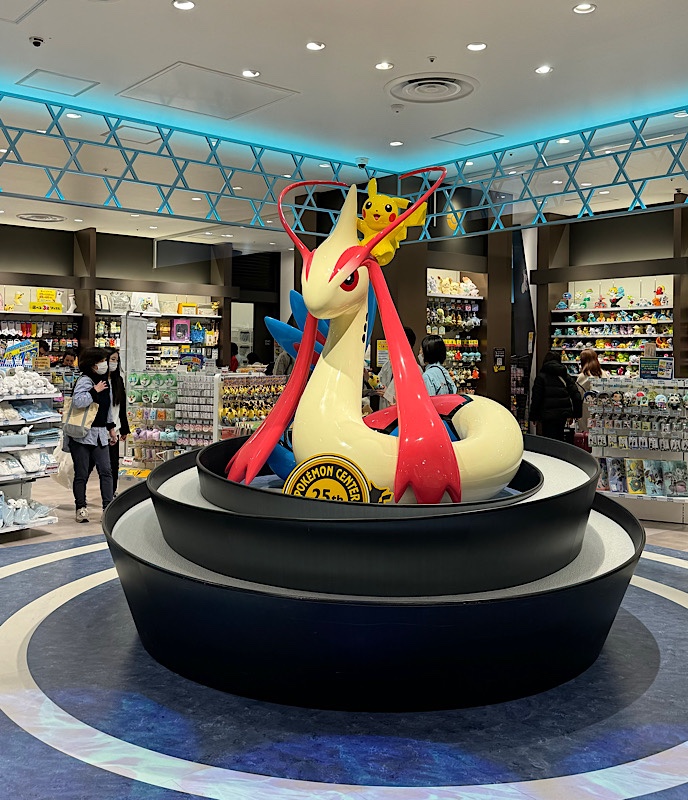 Pikachu in a kimono is apparently a limited edition Kanazawa Pikachu… the lady in the store went to great pains in broken English to let me know I couldn’t get this particuar stuffed Pikachu anywhere else.
Pikachu in a kimono is apparently a limited edition Kanazawa Pikachu… the lady in the store went to great pains in broken English to let me know I couldn’t get this particuar stuffed Pikachu anywhere else. 
 This wasn’t actually in the Pokémon store it was just a display in a regular chemist when I popped in looking for a nail file. Cute.
This wasn’t actually in the Pokémon store it was just a display in a regular chemist when I popped in looking for a nail file. Cute. 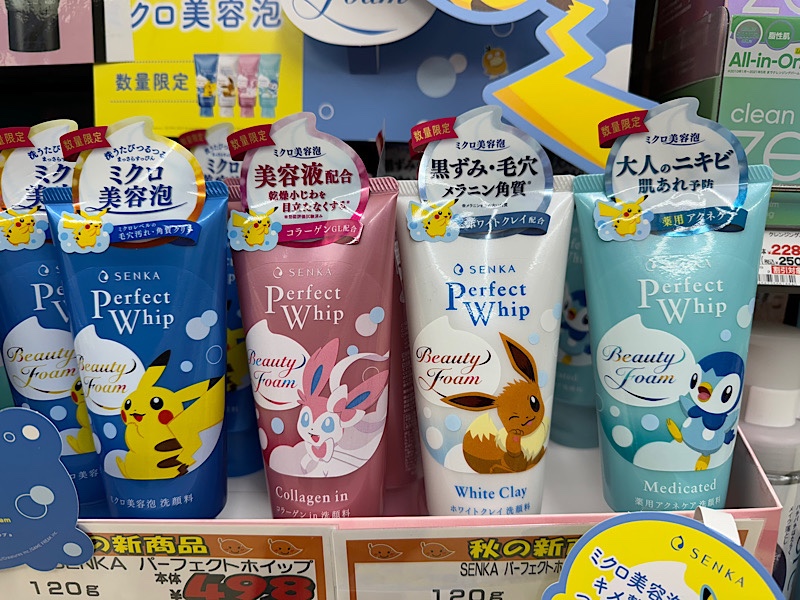
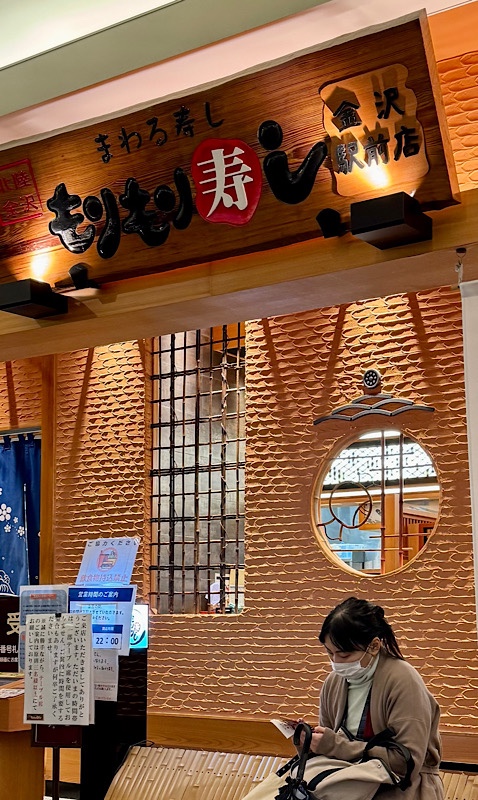 And wait we did! It was a good 45 minutes of listening to customers being called (in Japanese!) by the time we realised just how long a wait this was going to be! And by then you’re committed right? We ended up waiting about 75 minutes to get a table!
And wait we did! It was a good 45 minutes of listening to customers being called (in Japanese!) by the time we realised just how long a wait this was going to be! And by then you’re committed right? We ended up waiting about 75 minutes to get a table! This was definitely going to be one of those, ‘oh dear, I hope this is worth it’ things, and while I was pretty confident that I’d be happy with my wash once we managed to have some dinner, I was less confident that Mr K would find the wait worth his while given he’s not the sushi/sashimi fan in the fam.
This was definitely going to be one of those, ‘oh dear, I hope this is worth it’ things, and while I was pretty confident that I’d be happy with my wash once we managed to have some dinner, I was less confident that Mr K would find the wait worth his while given he’s not the sushi/sashimi fan in the fam.  Speedy conveyor built sushi train:
Speedy conveyor built sushi train: Mr K once he realised that his beer would arrive cold and immediately! Happy face – thankfully.
Mr K once he realised that his beer would arrive cold and immediately! Happy face – thankfully. The menu was quite extensive with pages and pages of offerings under each category, and our orders arrived really promptly.
The menu was quite extensive with pages and pages of offerings under each category, and our orders arrived really promptly.  Saké and beer to start, like there was any doubt about this. I had some Tateyama Gingo saké and it was cold and delicious (it’s getting so much easier to order a drop I know I will like, the more familiar I am becoming with the local products).
Saké and beer to start, like there was any doubt about this. I had some Tateyama Gingo saké and it was cold and delicious (it’s getting so much easier to order a drop I know I will like, the more familiar I am becoming with the local products).  The food was delicious and imho, well worth waiting for. I had some salmon an some yellow tail sashimi, as well as some maguro tuna and some ikura ships. Everything was delicious and fresh just as you would like hope at a Japanese port town.
The food was delicious and imho, well worth waiting for. I had some salmon an some yellow tail sashimi, as well as some maguro tuna and some ikura ships. Everything was delicious and fresh just as you would like hope at a Japanese port town.  Mr K catching up on some serious news.
Mr K catching up on some serious news.



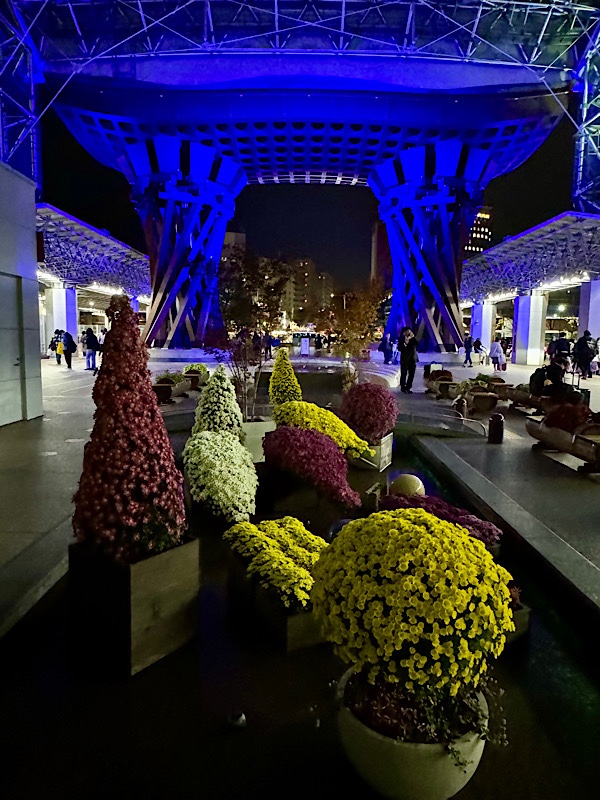
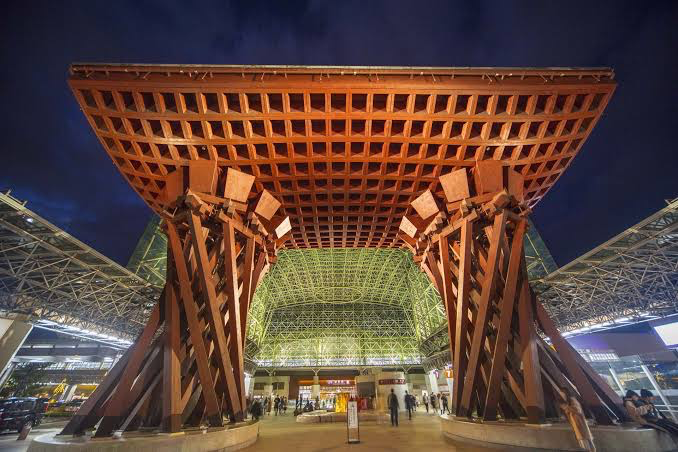
 The pics that show up when you search a place are often quite handy so you know what you are looking for…
The pics that show up when you search a place are often quite handy so you know what you are looking for… Anyway, you’d think this wouldn’t be too difficult a task… look up the brewery, find an address, type it into Google maps (and the car’s archaic GPS unit for good measure) and off you go! Oh if wishing made it so! We found the general area okay thanks to the aforementioned navigational devices, and then seemed to be stumbling around a bit lost until I saw this door – and remembered seeing it on the images that popped up on Google Maps. Awesome – we are in the right place. So I asked a guy who obviously worked there, who happened to be passing by, and he directed me slightly down the road to a doorway….
Anyway, you’d think this wouldn’t be too difficult a task… look up the brewery, find an address, type it into Google maps (and the car’s archaic GPS unit for good measure) and off you go! Oh if wishing made it so! We found the general area okay thanks to the aforementioned navigational devices, and then seemed to be stumbling around a bit lost until I saw this door – and remembered seeing it on the images that popped up on Google Maps. Awesome – we are in the right place. So I asked a guy who obviously worked there, who happened to be passing by, and he directed me slightly down the road to a doorway…. On the corner of the next block – totally not visible at all from where the ‘helpful’ worker was pointing was one of the buildings that I saw on the Google Map.
On the corner of the next block – totally not visible at all from where the ‘helpful’ worker was pointing was one of the buildings that I saw on the Google Map. 
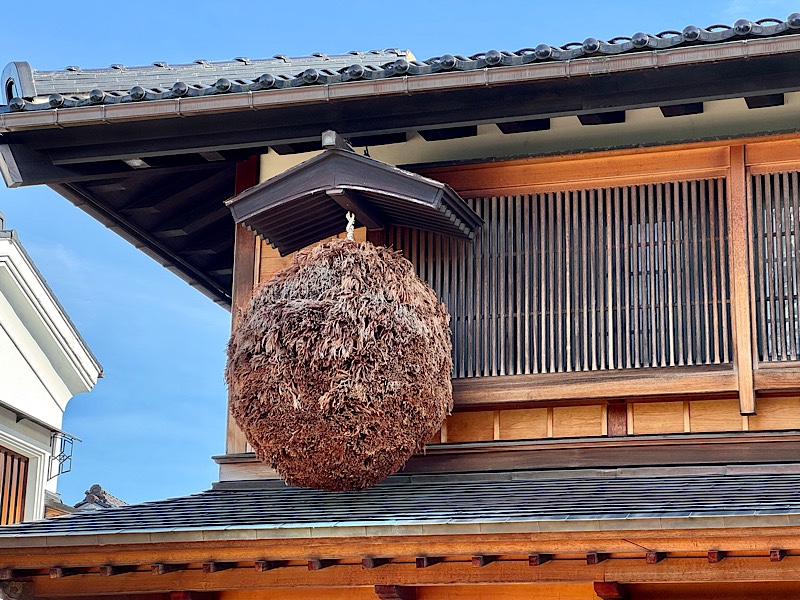




 And I can’t read a lick of kanji… when it comes to saké I know that I like ones on the dry end of the scale, not to heavy on the aroma. Definitely nothing sweet or cloying (some are downright syrupy), and I quite dislike saké that feels like it should be labeled ‘vodka’ or tastes of grain spirit. Over time I’ve learned that I like the junmai gingo or junmai daiginjo and I have been to enough breweries and tastings to have some favourites.
And I can’t read a lick of kanji… when it comes to saké I know that I like ones on the dry end of the scale, not to heavy on the aroma. Definitely nothing sweet or cloying (some are downright syrupy), and I quite dislike saké that feels like it should be labeled ‘vodka’ or tastes of grain spirit. Over time I’ve learned that I like the junmai gingo or junmai daiginjo and I have been to enough breweries and tastings to have some favourites. Oh and they had FIVE fridges this size all full of different offerings that you could try. Some of this fridge was full of vintage saké and limited edition runs which is a bit of a bitch because two of the ones I liked in this fridge aren’t even available for sale!
Oh and they had FIVE fridges this size all full of different offerings that you could try. Some of this fridge was full of vintage saké and limited edition runs which is a bit of a bitch because two of the ones I liked in this fridge aren’t even available for sale!  I tried about nine in my 15 minutes and took some photos of some favourites. I gotta say it was a lot of fun… there were a couple of other guests there who were also talking and laughing (in English) about tasting against the clock – they turned out to be Japanese and Croatian but both living and working in Berlin at the moment. We tried to divide and conquer a little but just ended up telling each other which ones to try. 🙂
I tried about nine in my 15 minutes and took some photos of some favourites. I gotta say it was a lot of fun… there were a couple of other guests there who were also talking and laughing (in English) about tasting against the clock – they turned out to be Japanese and Croatian but both living and working in Berlin at the moment. We tried to divide and conquer a little but just ended up telling each other which ones to try. 🙂 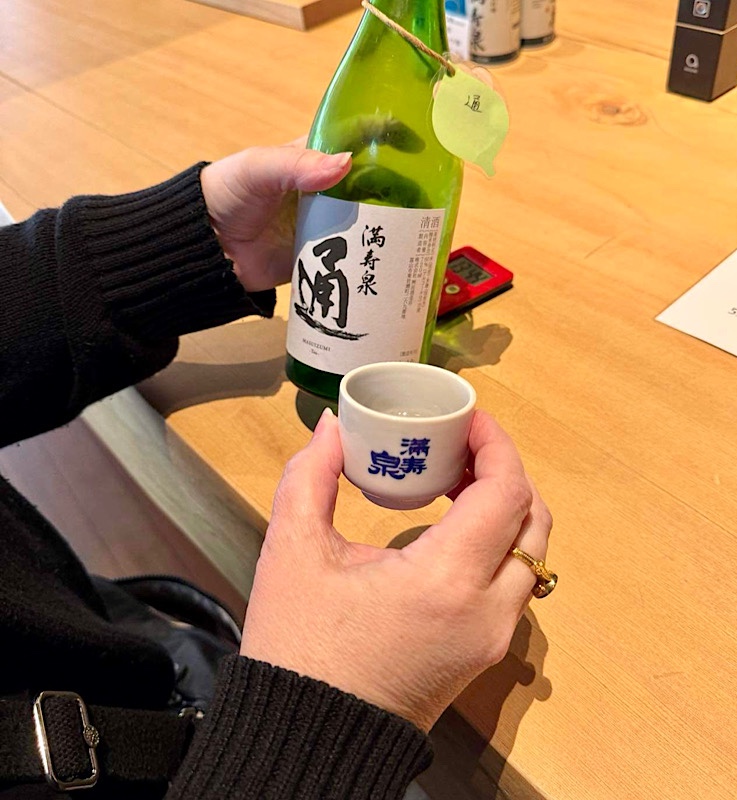 It was good fun – I bought a nice bottle of junmai daiginjo to take away and couple of little cups as a memento. Then we ventured south in search of the next brewery – which was the Yoshino Tomo brewery.
It was good fun – I bought a nice bottle of junmai daiginjo to take away and couple of little cups as a memento. Then we ventured south in search of the next brewery – which was the Yoshino Tomo brewery.  Thankfully a little easier to find. Definitely not as slick an operation as the Masuda brewery and we walked in and were hard pressed to find anyone to show us around or give us any information.
Thankfully a little easier to find. Definitely not as slick an operation as the Masuda brewery and we walked in and were hard pressed to find anyone to show us around or give us any information. 
 This little tanuki was by the door with a big ‘Welcome’ sign but to be honest it wouldn’t have surprised me if we were trespassing again – the welcoming committee was non-existent and we couldn’t seem to get any help at all.
This little tanuki was by the door with a big ‘Welcome’ sign but to be honest it wouldn’t have surprised me if we were trespassing again – the welcoming committee was non-existent and we couldn’t seem to get any help at all.
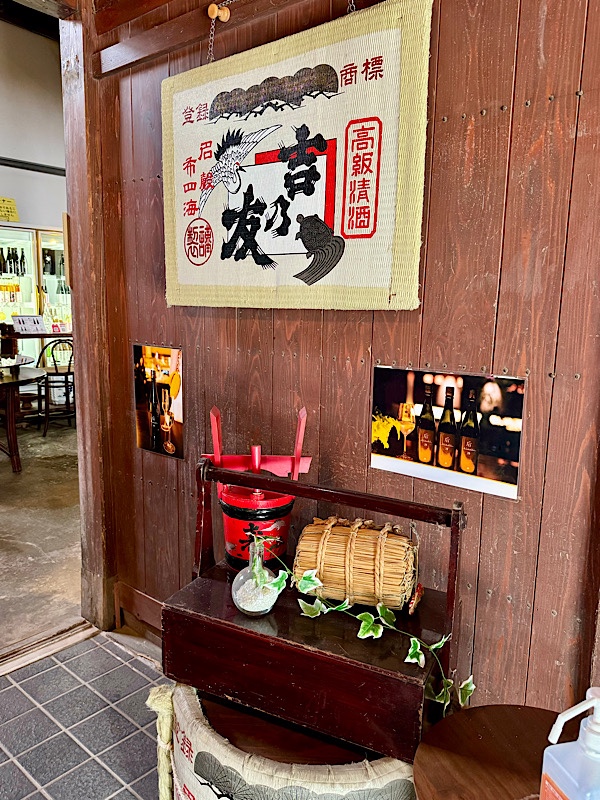 After poking around for a while and using Google Translate to decipher many many labels, we decided to bail out and took some notes of anything we might like to try down the track from the supermarkets. Seemed easier!
After poking around for a while and using Google Translate to decipher many many labels, we decided to bail out and took some notes of anything we might like to try down the track from the supermarkets. Seemed easier!

 I have seen the Kisaki pink in the shops before so now we have a bit more info, it might be worth giving some of these a try. At least the labels are distinctive so we’ll be able to recognise them easily.
I have seen the Kisaki pink in the shops before so now we have a bit more info, it might be worth giving some of these a try. At least the labels are distinctive so we’ll be able to recognise them easily. Oh look… there is the Masuizumi Junmain gingo at Lawson’s that I just bought at the last brewery, for JPY400 less than they charged at the tasting room! Oh well, live and learn. 🙂
Oh look… there is the Masuizumi Junmain gingo at Lawson’s that I just bought at the last brewery, for JPY400 less than they charged at the tasting room! Oh well, live and learn. 🙂  Next stop was a roadside services for lunch – and I have to say, even dodgy roadside food here is better than a lot of the cheap and cheerful Japanese restaurants that we have at home. I’d go so far as to say convenience store sushi is better than most Australian sushi trains restaurants. 😐 Disappointing but there you have it. This katsudon meal with miso soup was roughly AUD$10 – and it was delicious.
Next stop was a roadside services for lunch – and I have to say, even dodgy roadside food here is better than a lot of the cheap and cheerful Japanese restaurants that we have at home. I’d go so far as to say convenience store sushi is better than most Australian sushi trains restaurants. 😐 Disappointing but there you have it. This katsudon meal with miso soup was roughly AUD$10 – and it was delicious.




 Here, I met a lovely woman who had been living in the US for a number of years and her English was exceptional. We had an in-depth discussion about the various types of saké, and she led me through some tastings. She gave me a pile of information on different varieties and practices that various different breweries were engaging in.
Here, I met a lovely woman who had been living in the US for a number of years and her English was exceptional. We had an in-depth discussion about the various types of saké, and she led me through some tastings. She gave me a pile of information on different varieties and practices that various different breweries were engaging in.  Turns out, that without even realising it – I have developed a taste for ‘purest saké’ (because of course I have… champagne tastes on a beer budget my entire life!). Meaning that the sakés I have found I enjoyed the most are the ones with the least amount of additives. Anything with ‘junmai’ on the label is pure saké, made only with rice, natural waters and koji (koji being a fermentation culture). Which totally explains (for me, at least) why I dislike some saké because it’s too sweet, (likely has sugar added), or to strong in it’s alcohol taste, (likely has grain alcohol added).
Turns out, that without even realising it – I have developed a taste for ‘purest saké’ (because of course I have… champagne tastes on a beer budget my entire life!). Meaning that the sakés I have found I enjoyed the most are the ones with the least amount of additives. Anything with ‘junmai’ on the label is pure saké, made only with rice, natural waters and koji (koji being a fermentation culture). Which totally explains (for me, at least) why I dislike some saké because it’s too sweet, (likely has sugar added), or to strong in it’s alcohol taste, (likely has grain alcohol added).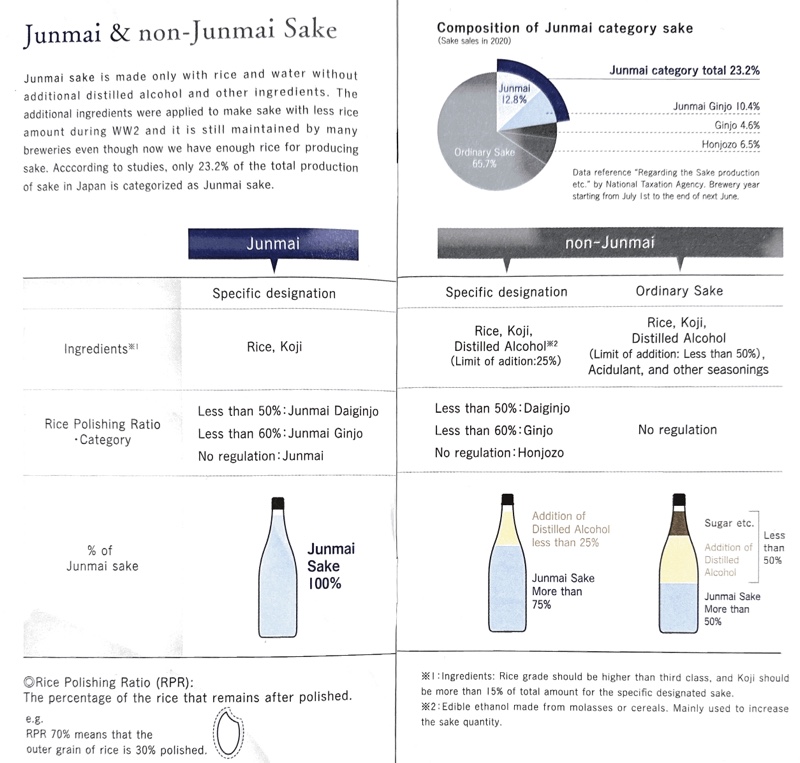



 This mural is called a Fusama painting and it was apparently created by Kahoolawe Ueshima, who is a well known local arts who works in the ParalymArt collective – I have no idea what that is, but it appears to be a significant art community according to our host.
This mural is called a Fusama painting and it was apparently created by Kahoolawe Ueshima, who is a well known local arts who works in the ParalymArt collective – I have no idea what that is, but it appears to be a significant art community according to our host. 
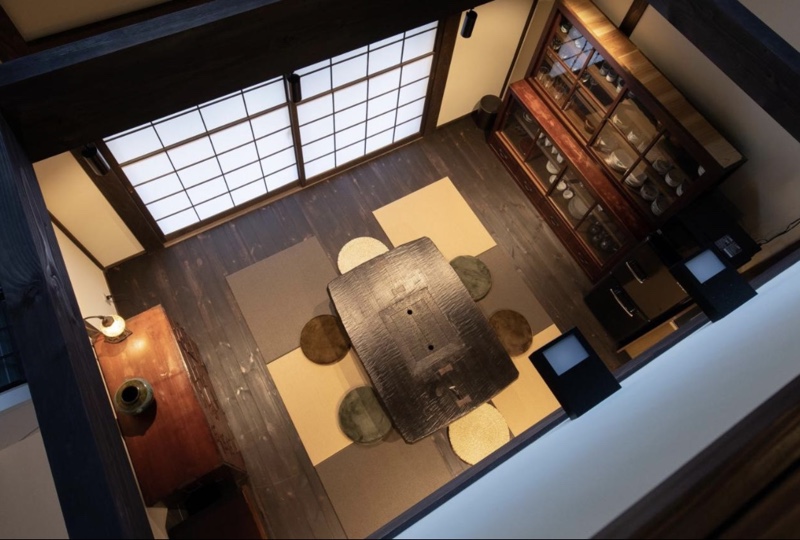
 We have a cute, private little garden space; I love the rain chains and have often wondered if they would look out of place in suburban Brisbane. lol
We have a cute, private little garden space; I love the rain chains and have often wondered if they would look out of place in suburban Brisbane. lol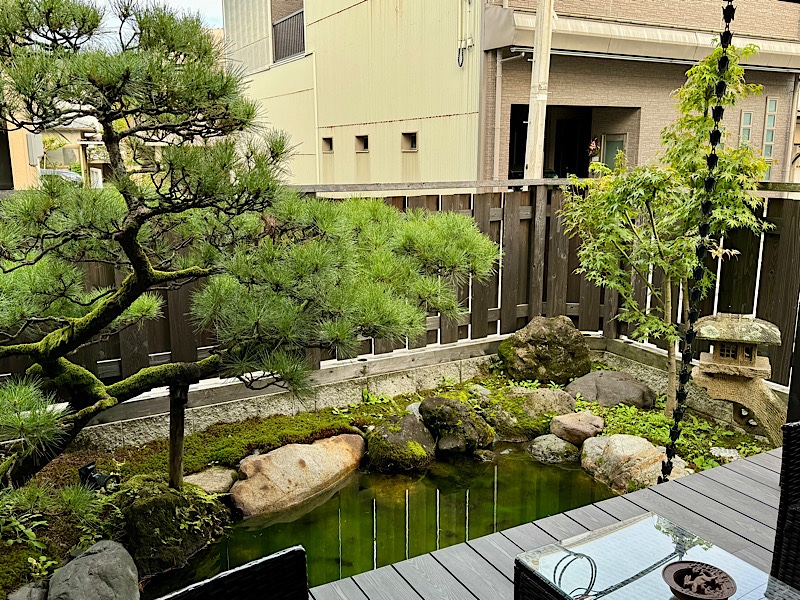
 Now to sit down to do some serious work, which of course requires – saké!!! Kanpai.
Now to sit down to do some serious work, which of course requires – saké!!! Kanpai.
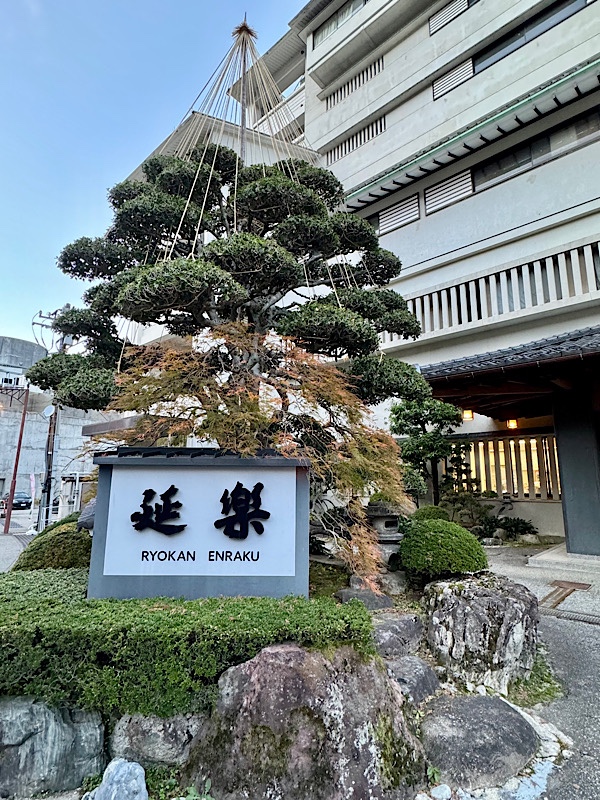 The lobby was lush, and set a beautiful warm and welcoming tone to the ryokan.
The lobby was lush, and set a beautiful warm and welcoming tone to the ryokan. Our rom was on the 11th floor with a large deck and garden that overlooked the gorge. The living room was set up for day use with some low chairs and tables on a large tatami mat space.
Our rom was on the 11th floor with a large deck and garden that overlooked the gorge. The living room was set up for day use with some low chairs and tables on a large tatami mat space.  Just past that was a sectioned off area with a dressing table and basin, fitted out with all sorts of amenities (toothbrush kits, hair brushes, shower caps, razors, shampoo, conditioner, lotions, face mask treatment things – all individually wrapped)…
Just past that was a sectioned off area with a dressing table and basin, fitted out with all sorts of amenities (toothbrush kits, hair brushes, shower caps, razors, shampoo, conditioner, lotions, face mask treatment things – all individually wrapped)…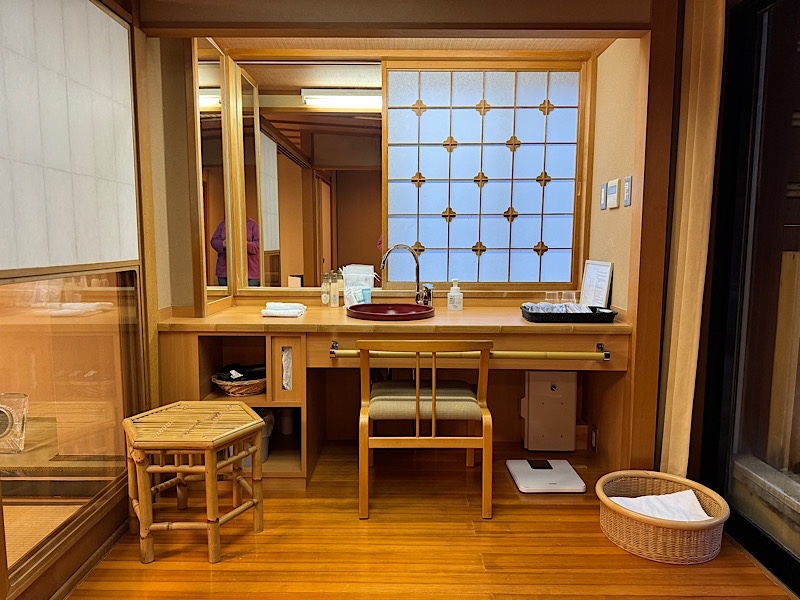 …opposite that is a pair of low chairs and a table for reading, relaxing or sitting and having a drink.
…opposite that is a pair of low chairs and a table for reading, relaxing or sitting and having a drink.
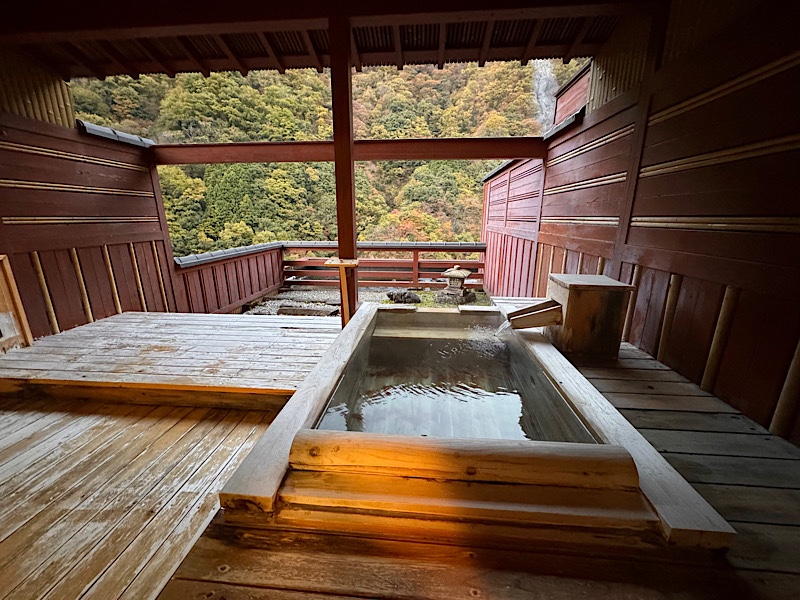 The bath was so inviting we jumped in almost as soon as our attendant left the room. 41C and absolutely divine. The rail trip up to gorge was great and it’s mostly a summer activity (closes down from end of November until April in fact) so it was rather cold sitting in the open sided carriages for quite a long time today.
The bath was so inviting we jumped in almost as soon as our attendant left the room. 41C and absolutely divine. The rail trip up to gorge was great and it’s mostly a summer activity (closes down from end of November until April in fact) so it was rather cold sitting in the open sided carriages for quite a long time today.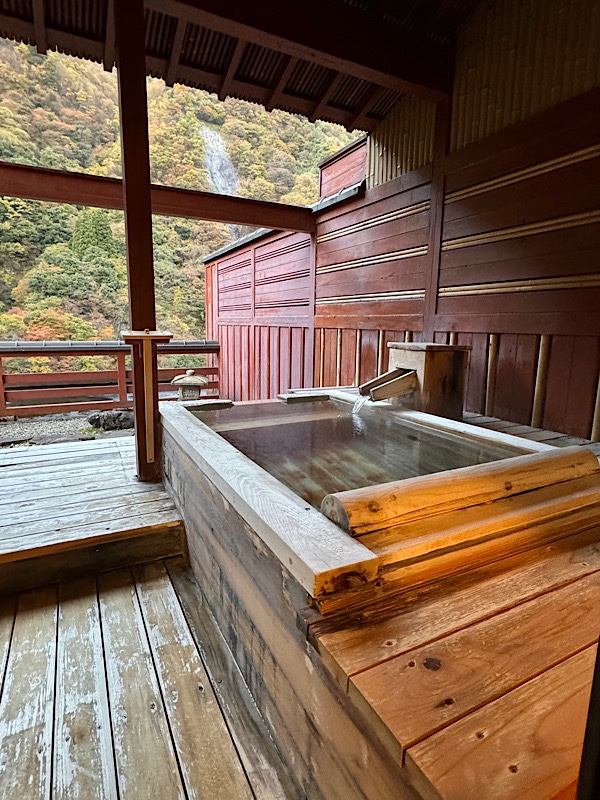


 Back inside off the vestibule, (yes there is an entrance space that is most aptly described as a vestibule!) is the interior actual bathroom area… which consisted of three more rooms! A dressing room, a separate toilet and another shower and cypress bath area.
Back inside off the vestibule, (yes there is an entrance space that is most aptly described as a vestibule!) is the interior actual bathroom area… which consisted of three more rooms! A dressing room, a separate toilet and another shower and cypress bath area.  This bath is set into the floor and fully 70cm deep. The whole space is made of our cypress and smells amazing.
This bath is set into the floor and fully 70cm deep. The whole space is made of our cypress and smells amazing. After our dip in the onsen we caught up on some emails etc for a while until it was time to go to dinner – which was being served down the hall in a lovely private dining room.
After our dip in the onsen we caught up on some emails etc for a while until it was time to go to dinner – which was being served down the hall in a lovely private dining room. Our meal consisted of some assorted amuse bouche type things – one of these was tofu with a walnuts in an unknown but delicious sauce, another was some pickled something or other with some Imari, and the third was a mushroom tofu thingamebob that was fantastic.
Our meal consisted of some assorted amuse bouche type things – one of these was tofu with a walnuts in an unknown but delicious sauce, another was some pickled something or other with some Imari, and the third was a mushroom tofu thingamebob that was fantastic.  A grouper soup…
A grouper soup…

 Lily bulb and some fresh sashimi served with irizake dipping sauce…
Lily bulb and some fresh sashimi served with irizake dipping sauce…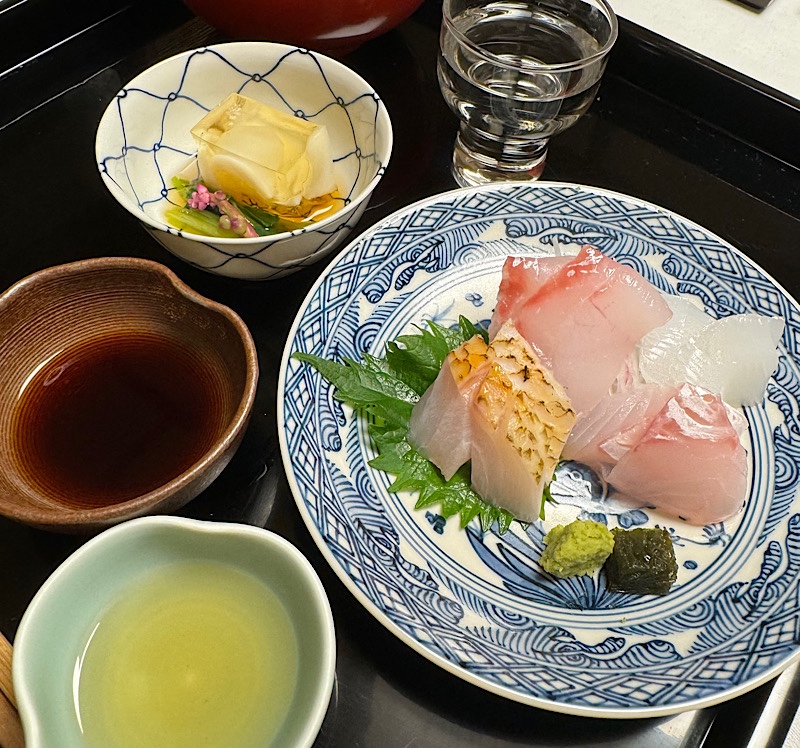

 Female snow crab…
Female snow crab… 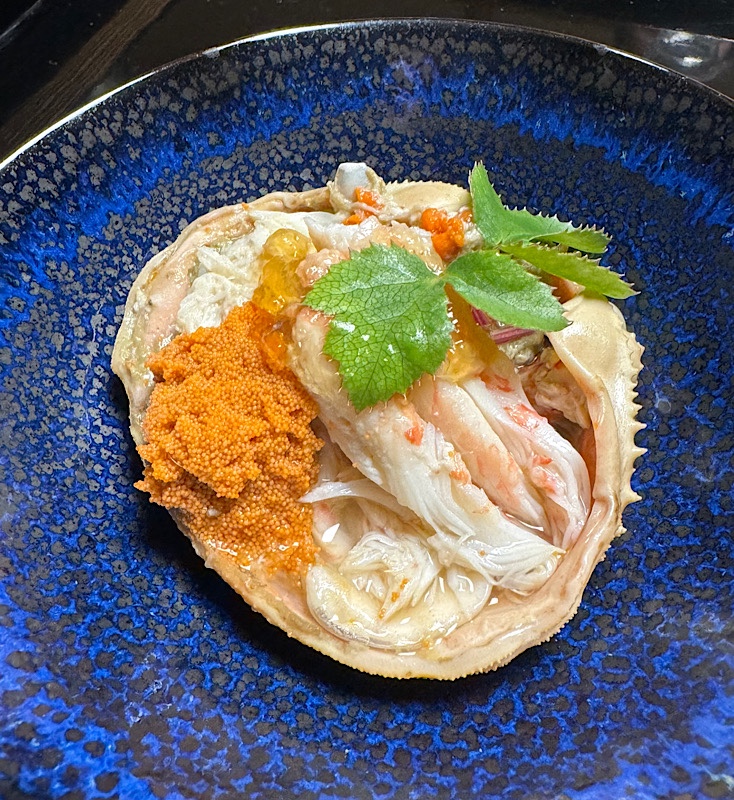 Karaage shrimp!
Karaage shrimp! Grilled black throat fish with miso yuan and some heavily marbled waguy beef to cook on a black stone.
Grilled black throat fish with miso yuan and some heavily marbled waguy beef to cook on a black stone. 





 Then a small bowl of local Toyama rice (which apparently is some of the best in the country and explains why there are so many saké breweries around here) served with some red miso soup filled with mushrooms.
Then a small bowl of local Toyama rice (which apparently is some of the best in the country and explains why there are so many saké breweries around here) served with some red miso soup filled with mushrooms.  Finally topped off with some fresh fruit – I have to hand it to the Japanese, even though I come from the sub-tropics and fresh fruit is plentiful year round, the Japanese have amazing quality fruits.
Finally topped off with some fresh fruit – I have to hand it to the Japanese, even though I come from the sub-tropics and fresh fruit is plentiful year round, the Japanese have amazing quality fruits. When we got back to the room, our attendant had made up our futons for the night and we let dinner settle and then hightailed it back into the onsen for another soak!
When we got back to the room, our attendant had made up our futons for the night and we let dinner settle and then hightailed it back into the onsen for another soak!


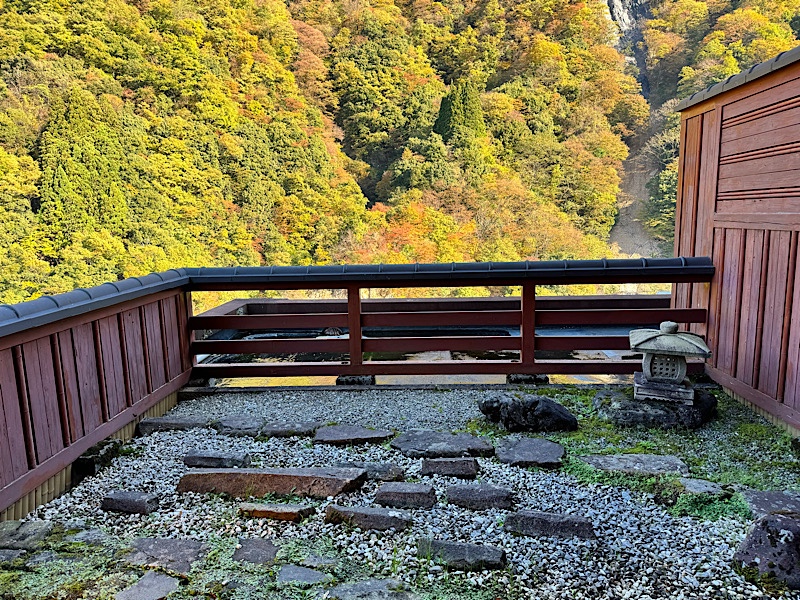








 The railway runs a daily schedule of open carriage trains from April to November every year, and shuts down for the winter due to the heavy snowy conditions.
The railway runs a daily schedule of open carriage trains from April to November every year, and shuts down for the winter due to the heavy snowy conditions.
 The startlingly green colour to the water here is due to the white granite below – I imagine in the spring it looks particularly lush and green. There are a lot of photos in this post, it was so beautiful I had a hard time editing them out. 🙂
The startlingly green colour to the water here is due to the white granite below – I imagine in the spring it looks particularly lush and green. There are a lot of photos in this post, it was so beautiful I had a hard time editing them out. 🙂 


 There are multiple waterfalls down the rugged cliff sides along the route. This place has a spectacular location. The railway winds its way up the gorge past many beautiful vistas, through loads of tunnels and past several stops – some of which are open for the public to stop at and explore and others that are for the access of workers and equipment.
There are multiple waterfalls down the rugged cliff sides along the route. This place has a spectacular location. The railway winds its way up the gorge past many beautiful vistas, through loads of tunnels and past several stops – some of which are open for the public to stop at and explore and others that are for the access of workers and equipment.

 It got quite cold – especially in the chilly air in the tunnels and we were glad to have bought coats , scarves and beanies. I failed on the footwear front though – I should have put on my boots!
It got quite cold – especially in the chilly air in the tunnels and we were glad to have bought coats , scarves and beanies. I failed on the footwear front though – I should have put on my boots! Kurobe Dam
Kurobe Dam
 The autumn colours are gorgeous.
The autumn colours are gorgeous. 











 At the end of the scenic railway track is the Keyakidaira Station where you can disembark and spend some time exploring. They have very thoughtfully built viewing platforms, a pedestrian walkway to go further into the gorge, a gift shop (of course!) and restaurants.
At the end of the scenic railway track is the Keyakidaira Station where you can disembark and spend some time exploring. They have very thoughtfully built viewing platforms, a pedestrian walkway to go further into the gorge, a gift shop (of course!) and restaurants.  We found ourselves some warming chicken and curry for lunch and I mostly just found that saké was helpful to warm back up again! 😀 Mr K was pretty happy wish his wash.
We found ourselves some warming chicken and curry for lunch and I mostly just found that saké was helpful to warm back up again! 😀 Mr K was pretty happy wish his wash.  Found a new favourite light and dry saké (I’m not super keen on the sweet ones). This one is from the Tateyama Sake Brewery and it’s called Honjozo saké. Turns out their brewery is on our way to Kanazawa tomorrow so we might try and stop by to check it out if it is open to the public. ( www.sake-tateyama.com/en/ … that’s more for me than for anyone else).
Found a new favourite light and dry saké (I’m not super keen on the sweet ones). This one is from the Tateyama Sake Brewery and it’s called Honjozo saké. Turns out their brewery is on our way to Kanazawa tomorrow so we might try and stop by to check it out if it is open to the public. ( www.sake-tateyama.com/en/ … that’s more for me than for anyone else).
 Mr K on the bridge, starting to do ‘the YMCA’…
Mr K on the bridge, starting to do ‘the YMCA’…  One thing we did notice was that there didn’t seem to be a lot of wildlife visible from the train. I mean, we did see some cheeky monkeys near the monkey crossing bridge on the way back but that was pretty much it. Mr K spotted this poster which was asking members of the public to report sightings of local wildlife… I have no idea what this funny looking llama crossed with a dik-dik thing is, but we didn’t see any of them.
One thing we did notice was that there didn’t seem to be a lot of wildlife visible from the train. I mean, we did see some cheeky monkeys near the monkey crossing bridge on the way back but that was pretty much it. Mr K spotted this poster which was asking members of the public to report sightings of local wildlife… I have no idea what this funny looking llama crossed with a dik-dik thing is, but we didn’t see any of them.

 The views on the way back were just as spectacular – though some of our travelling companions mustn’t have thought so as there were many on their phones and I even saw one man sleeping on the way back.
The views on the way back were just as spectacular – though some of our travelling companions mustn’t have thought so as there were many on their phones and I even saw one man sleeping on the way back.










 I believe the building behind this bridge with the red roofs is the Enraku – the ryokan/onsen that we have booked to stay tonight.
I believe the building behind this bridge with the red roofs is the Enraku – the ryokan/onsen that we have booked to stay tonight. 
 Oh and just because I love a good taxidermy fail – I have included this bear that I saw at the Kurobe Railway Unizaki Station! Spectacular!
Oh and just because I love a good taxidermy fail – I have included this bear that I saw at the Kurobe Railway Unizaki Station! Spectacular! 